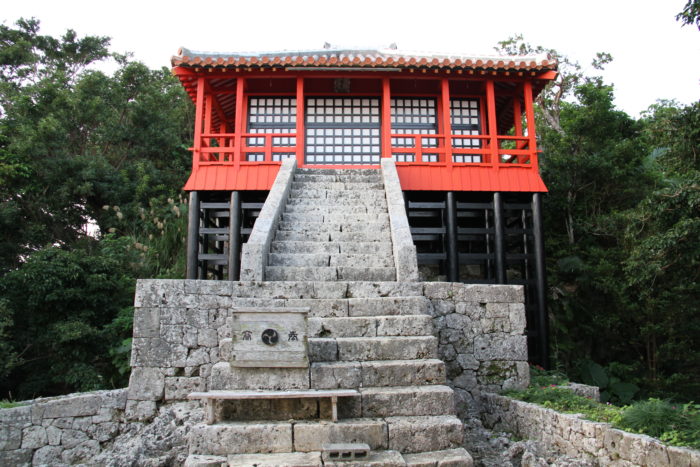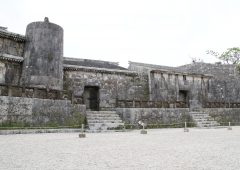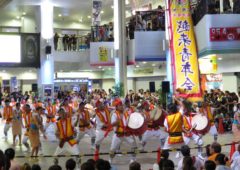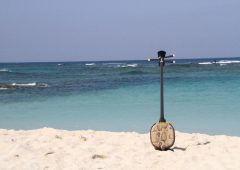2023.12.31
Visiting Okinawan Shrines for the New Year
Have you ever partaken in a Hatsumoude? Have you even heard of a “Hatsumoude”?
“Hatsumoude” is a Japanese custom where Japanese people pay a visit to a shrine or temple on January 1st, starting at midnight. The emphasis is that this will be your ‘very first visit to a shrine or temple of the year’.“Hatsu” means “first” and “moude” means “visiting a shrine or temple” or “paying homage”. These days, most Japanese visit a shrine or temple only once for “Hatsumoude”. This meaning has changed over time as people from long ago used to visit frequently.
We introduce eight shrines on Okinawa at this time, known as the “Ryukyu Hassha,“ meaning the “8 shrines of the Ryukyu’s“. These 8 shrines were assigned a special status by the Ryukyu Government before the Meiji Era came into fruition.
So where are the Ryukyu Hassha shrines located?
Oki-no-Guu is located inside Onoyama Park in Naha (Note that Onoyama Park holds three different shrines in close proximity). The other shrine, “Gokoku Shrine” is the most popular shrine in Okinawa for this generation. Almost 240,000 people visit every New Year season.
Naminoue-Guu is located next to Naminoue Beach in Naha City. It is considered the highest ranking shrine among the Ryukyu Hassha. It is currently the second most popular shrine for “Hatsumoude” visits with almost 150,000 people in attendance. You can find the “Gokoku Temple” next to the Naminoue shrine. Some Okinawans confuse the Gokoku Shrine at Onoyama with the Gokoku Temple at Naminoue.
The most popular shrine for foreigners is the 3rd ranking “Futenma-Guu” located in Futenma. Futenma-Guu has a cave under the shrine where the god of Futenma resides. One cannot enter the cave during the New Year season because it is so busy at that time. However, the cave is open to the public after January.
Sueyoshi-Guu is located inside Sueyoshi Park in Shuri. Its location is somewhat mystical being that it is located deep in the park’s forest. One can enter the place from either the Shuri or Urasoe side, but it is recommended to visit from the Urasoe side at midnight. At night, it becomes difficult to climb the hill from Shuri. The alter inside the shrine is normally closed off to the public, except during New Years.
Ameku-Guu is located near Tomari Port in Naha City. It’s located next to a temple.
Shikina-Guu is located near the “Shikina En” World Heritage Park. It is not a big shrine, and since it is located inside a residential area, it is recommended that you visit the shrine on foot when you park at the park grounds of Shikina Park. As an added bonus, you can see some relics of the old Okinawan lifestyle in that area.
Asato Hachiman-Guu is located in the Asato District in Naha City. Perhaps, this shrine is the most difficult place to visit because the roads are so narrow, and some roads are only one-way. Arriving close to the shrine by vehicle is next to impossible, even for a regular size car. It is recommended you park your car near Naha Kokusai Street and visit by foot.
Kin-Guu is located near Camp Hansen in Kin Town. Because of its proximity to Camp Hansen, it too is a popular shrine for foreigners. But do you know where the actually shrine is? Most Okinawans do not know as well. At first glance, you can see only the “Kannon Temple”, so there is confusion on where the actually shrine is? The answer – it is underground. Off to the side is a cave entrance that goes down underneath the earth. It is in their where the god is enshrined. The cave is also used as a natural refrigerator for Awamori liquor. The environment there is considered ideal for maturing old Awamori. Over the years huge number of bottles and pots of Awamori have been stored there – sleeping with the gods.
Foreigners of other religions should not view participating in a Hatsumoude as a sacrilege of their own religion. It is not a matter of religion, but rather a custom of bringing in the New Year. One must remember that the majority of Japanese people do not strictly follow a particular religion. They go because it is a custom and tradition dating back generation to generation. Visiting a shrine during New Years will give you an understanding of Japanese customs and an insight to the Japanese psyche.
The procedures for entering and praying at the shrine and temple are very similar for the most part. If you enter through a Torii gate, please bow before entering; this is a form of acknowledgement that you are entering a sacred area. After entering the gate, wash your hands and mouth at the Chozuya fountain to “cleanse your soul and body” before you approach the enshrined god to pray. At the fountain, take the dipper with your right hand, fill it with water, and wash your left hand. Then take the dipper in the left hand and wash the right hand. After that, form your hand into a cup and take the dipper with the right hand again and pour water inside your left hand, then wash your mouth using that water (do not ever use the dipper to put water in your mouth). Put back the dipper back and you are finish with the cleansing.
After washing, just walk to the front of the “Haiden”. Sometimes you will find a shrine without a Haiden or an offering box, so just praying is fine. When you arrive in front of the Haiden, bow twice and then throw a coin, usually 5 yen or more, inside the offering box, then ring the bell that’s hanging from the ceiling (a temple doesn’t have this kind of a bell, so just throw your money in the box and pray). After that, clap your hands twice and keep your hands joined together to pray for whatever you are hoping for. Most Japanese pray for their health, family safety, and/or something special in need. Then bow one more time before you step away from the Haiden. It is also good to bow back at the shrine when you are under the Torii gate as you are leaving. Those are the formal manners for visiting and praying at a shrine or temple.










 2024.07.07
2024.07.07 2024.07.02
2024.07.02 2024.06.11
2024.06.11 2024.06.03
2024.06.03 2024.05.02
2024.05.02 2024.04.26
2024.04.26 2024.04.04
2024.04.04 2024.04.02
2024.04.02 2024.03.03
2024.03.03 2024.02.26
2024.02.26






